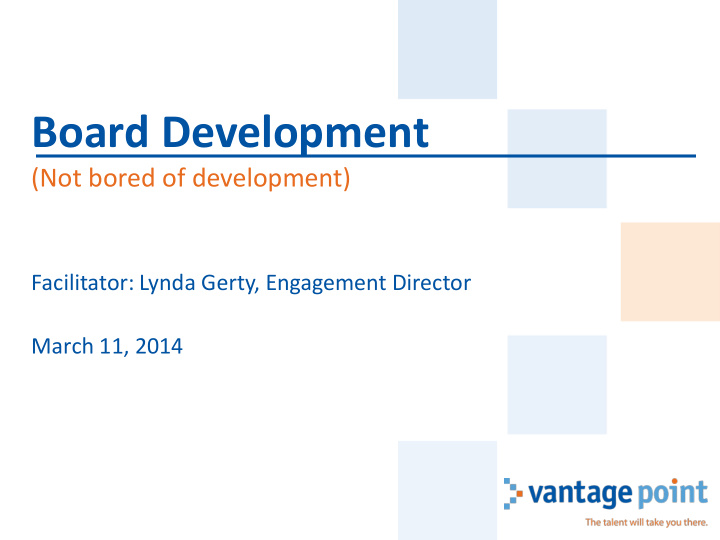



Board Development (Not bored of development) Facilitator: Lynda Gerty, Engagement Director March 11, 2014
“ every community mindfully engages passionate citizens . ” -Our Vision Tweet about today’s session: @vantagepnt
Agenda • Organizational functions : governance, management and operations • Roles and responsibilities of board members • Three modes of governing : fiduciary, strategic and generative • Six characteristics that enable great board work • Your organization and next steps
Learning Outcomes At the completion of this workshop you will be able to: • Differentiate between governance, management and operations • Define the 11 responsibilities of board members • Define fiduciary, strategic and generative roles • Analyze your board strengths and opportunities to improve based on six characteristics that enable great board work
External and Future Looking
Board Responsibilities… Taking care of itself Taking care of the organization
Wisdom in the Room What qualities of governance characterize a great board?
Governance and Management GOVERNANCE [visioning; policy; strategic planning] MANAGEMENT [Supervising staff; preparing budgets] OPERATIONS [Program/Service Delivery, day-to-day ops]
Which Hat & When?
11 Responsibilities of the Board 1. Determine the Organization’s Mission & Purpose 2. Select & Support the Executive & Review His/Her Performance Periodically 3. Approve & Monitor the Organization’s Programs & Services 4. Resource Development 5. Ensure Effective Fiscal Management 6. Engage in Planning Strategically 7. Carefully Select & Orient New Board Members 8. Understand Relationship Between Board & ED 9. Enhance the Organization’s Public Image 10. Organize Itself So That the Board Operates Efficiently 11. Ensure Sound Risk Management Policies
Activity Pick three of the responsibilities that are most important to you and complete the assessment.
Creating Direction and Alignment LEADERS Management Performance Objectives Activities Strategies Goals Governance Success Mission Vision Values Adapted from the Wilcox Model for Effective Nonprofit Leadership
Activity Pair up with the person next to you and share the vision and mission of your organization
Modes of Governing Generative Fiduciary Strategic
Fiduciary Mode
Fiduciary Questions • Can we afford it? • What’s the opportunity cost? • Is the budget balanced? • Does it reflect our priorities? • Is it legal? • Is it ethical? • Are we doing it right?
Strategic – the Planner!
Strategic Questions • Is our “business model” viable? • How will new directors effect our support and public perceptions? • What are the trends and factors beyond our control that we need to consider?
Generative – the Visionary!
Generative Questions • How does this reflect our organizational values and beliefs? • How can we reframe this issue? • How does this affect our vision for the future? • Who do we serve? • Are we relevant?
Let’s Break & Re-energize
Exercise The Players Boston Museum of Fine Art Bellagio Casino Credit: Bill Ryan, Governance as Leadership co-author
Activity: What would you do? As the Board of Directors, should the Boston Museum of Fine Art lend 21 Monet paintings to Bellagio Casino in Las Vegas?
What really happened The Boston Museum of Fine Arts loaned the 21 paintings to the Bellagio’s Gallery of Fine Art. The exhibition drew 250,000 visitors during its first 7 months .
Reflections • What modes does your board normally think in? • What modes do you usually think in? • What can we to incorporate all three modes of governance into our work?
The Roots of GREAT Board Work 1. Structure 2. Clarity for Board Members 3. Effective Meetings 4. Continual Improvement 5. Team vs. Group 6. Continuity of Board Leadership
1. Structure Board Advisory Committees Board Executive Director Operational Task Force Committees
2. Clarity for Directors • Role descriptions • Letter of Agreement • Board Handbook • Annual calendar of events
3. Effective Meetings • Forward looking and lean agenda • Consent agenda • Time discipline • Role vigilance • Decision are made • Effective participation
4. Continual Improvement • Board Development Committee • Board self evaluation • Skill development areas • Retreats/Special sessions
5. Team vs. Group Local baseball team going to 8:15am weekday city bus provincials
6. Continuity of Leadership “Our first board report is from the recruitment committee”
6. Continuity of Leadership Cont… Contingency Succession Strategic Recruiting Planning Planning • Short & long-term •Broaden connections Identify Required: to resources & a •Core competencies • Board approved variety of perspectives •Qualities policy •Talent •Cultivate from within • Interim leadership •Job shadow • Agency workforce •Rigorous on-boarding Identify Future Required: plan process •Core competencies •Qualities •Talent
Activity: How is my board doing? 1. Structure 2. Clarity for Board Members 3. Effective Meetings 4. Continual Improvement 5. Team vs. Group 6. Continuity of Board Leadership
Reflection 1. How will you think differently; or interact with your board members differently; or engage with your work differently? 2. What is your next step to make that a reality?
Additional Resources Vantage Point Resources: www.thevantagepoint.ca/content/resource-centre Other Resources: • Governance as Leadership by Chait, Ryan & Taylor c. 2005 • The Abundant Not-for-Profit by Colleen Kelly & Lynda Gerty c. 2013 • Board Source: www.boardsource.org
Thank you! Lynda Gerty Engagement Director lgerty@thevantagepoint.c a Vantage Point 604.875.9144 1183 Melville Street Vancouver, B.C. V6E 2X5 facebook.com/vantagepnt @vantagepnt linkedin.com/company/vantagepnt
Recommend
More recommend